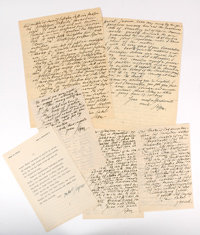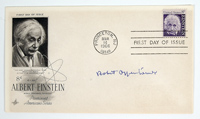
|
Sale 43
Manuscript and Collectibles Auction
| Lot |
Photo |
Description |
Realized |
Lot 205 |
 |
Freud, Sigmund (1856-1939) Austrian neurologist and founder of paychoanalysis. An archive of seven letters, six ALsS and one TLS (four signed "Sigm," one "Onkel Sigm" and one "Freud"; one has the signature removed), on "Prof. Fr. Freud / Wien, IX., Berggasse 10" stationery, five in German, two in English, total of 15 pages, six pages are 11¼" x 8¼", nine are 8¼" x 5¼", Vienna (the Sept. 14, 1923 letter has "Rome" above the engraved address), written between Sept. 27, 1919 and Mar. 14, 1924. All very fine except for the one missing signature on the July 20, 1920 letter, which partially affects three lines of text on the recto; otherwise, boldly penned and signed.
Freud, "the father of psychoanalysis" writes to his nephew, Edward Bernays, who was one of the founders of the public-relations industry, and who used his uncle's psychoanalytic ideas to indirectly promote the sale of commodities. Bernays (1891-1995) was the son of Freud's sister Anna, as well as the son of Feud's wife Martha Bernays' brother, Ely Bernays. Although born in Vienna, Edward Bernays was raised in the United States. He spent many summers in Vienna and became acquainted first-hand with his uncle's theories on the unconscious mind. Bernays opened an office in June 1919, styling himself a "public relations counsel." His public relations efforts helped introduce Freud's theories and made the book, Introductory Lectures on Psychoanalysis a best seller in America.
In his letter of September 27, 1919, Freud discusses publishing his book. He complains that the suggestion of first publishing the book in a Sunday supplement or a weekly periodical is typically American and unacceptable: "I heard from Mr. Hirsch that your intention was to have the translation published as part of the Sunday supplement of a newspaper, or in a weekly periodical. I cannot possibly give my consent to this. Altogether this would be too American for us over here, and even in America many would consider it as inconsistent with scientific practice." Freud insists that the translator not only be fluent in German and English, but that he be an analyst, "I must also insist that the translator carry certain guarantee. Not only should he have an intimate acquaintance with both languages but no less with the subject matter of psychoanalysis. He ought to be an analyst himself, otherwise this translation might do great harm."
Bernays did manage to hire a Ph.D. in psychology from Columbia University, a Miss Hoch, but her lack of psychoanalytical background led to a crucial problem, spelled out by Freud in the third letter of this group, dated July 20, 1920: "I have noted a number of misprints and misunderstandings which I am listing and shall put at your disposal for a second edition. You may tell the translator that I understand the difficulties which exist in rendering errors and dreams into another language, but I do not consider the expedient he used of inventing similar examples to be the correct method. Such inventions do injustice to the author and deprive the presentation of its plausibility. The only proper thing to do would have been to substitute for the untranslatable examples of slips of the tongue, puns in dreams, etc., other examples based on his own analytical experience, and occasionally to annotate the German example. But then the translator would, of course, have had to be an analyst, as for instance Dr. Brill [Dr. Abraham A. Brill, Freud's American disciple and translator of some of his earlier papers and books]. I am afraid that the reviewers will not fail to emphasize this shortcoming….For example, I note the use of the word 'Suppression' for 'Verdrangung.' In the literature in England, it has been agreed to translate this as 'Repression.'"
The second letter of this group, written Jan. 4, 1920, is in English and asks, "…Would you not consider the thought of entering into business relation with our 'Internat. psychoanalytic Verlag,' which is creating just now an Intern.td Press in London for bringing out a new Anglo-American Journal of PsA? You can help us a great deal. I will advise my man Dr. Otto Rank…and our Editor Dr. Ernest Jones…." Freud rejects the idea of a lecture tour to the U.S. because of his health [he was diagnosed with cancer of the mouth in 1919] and because of the costs involved in the trip. He adds, "I will be very glad if your translation of the book gains the material and scientific success you expect, but my manner is not obtrusive, I do not consider myself a person of public notoriety such as may be entitled to appeal to the American people on behalf of the Austrian people and in my own country at least I am in the dark…."
Bernays obtained for Freud a 15% royalty for the first edition of 3000 copies of the book, which appeared in 1920 under the title A General Introduction to Psychoanalysis and which sold for $4 a copy. On April 24, 1921, Freud writes in English, acknowledging receipt of $1911.08 and rejoicing "in the success of the book, 4325 copies bearing witness to the attention it found in your queer country…I am deeply touched by your unselfish zeal in this matter…a kind device of yours to assist me your uncle in these hard times…."
Many other editions followed, for this proved the most accessible of Freud's works for the layman; it was translated into over 15 languages and was successful in Austria and abroad. In a letter dated May 28, 1922, Freud refers to this book as "the only book from which I receive respectable payments," and he admits to "the popularity of Psychoanalysis in America." In another letter, he again refers to "the only book which pays."
Bernays showed remarkable patience in defending American mores in his efforts to publicize his work through such modern public relations techniques as interviews with journalists, lecture tours, magazine articles, and even responses to written criticisms or misinterpretations. The end result was that Freud became a true scientific hero in the United States.
Extracts from the correspondence are published in Edward Bernays' Biography of an Idea, 1965.
Estimated Value $100,000 - 125,000.
View details and enlarged photo
| Unsold |
Lot 206 |
|
Millikan, Robert A (1868-1953) Scientist, educator, and author who made many discoveries in the fields of electricity, optics, and molecular physics; he won the 1923 Nobel prize in physics. IBS, "Inscribed by the author, Robert A Millikan, as a gift from Theresa Dierkes to Mr. Jack Pike. March 10, 1953" in blue ink on the first end page of The Autobiography of Robert A. Millikan. Minor chips to spine of dust jacket and light toning to text.
Estimated Value $150 - 200.
View details
| Unsold |
Lot 207 |
 |
Nobel Prize Winners - Group of 15. Group of 14 signed photos of various sizes, plus one signature on a card. The group includes six winners in physics:, L.W. Alvarez (1968), C.H. Townes (1964), Walter H. Brattain (1956), C.D. Anderson (1936), Maria Goeppert Mayer (1963),and R.S. Mulliken (1966-signature on a 3" x 5" card). Six winners in physiology and medicine include: F.C. Robbins (1954), James D. Watson (1962), Albert B. Sabin (1954), Selman A. Waksman (1952), Glenn T. Seaborg (1962), John F. Enders (1954). One winner in chemistry: W.F. Libby (1960), one in literature: Karl Menninger (1954), and one recipient of the Crafoord Prize, awarded by the Royal Swedish Academy of Sciences in Stockholm each year since 1982 for scientific research in areas not recognized by the Nobel Prizes: J. Van Allen. Most are fine and come with transmittal envelopes.
Estimated Value $400 - 600.
View details and enlarged photo
| Unsold |
Lot 208 |
 |
Oppenheimer, Robert (1904-1967) American physicist; director of the Manhattan Project, which developed the first nuclear weapons; known as "the father of the atomic bomb." FDC signed in blue ink. The cover has a cachet of Albert Einstein and a cancelled 8¢ stamp, postmarked Princeton, NJ, Mar. 14, 1966. Very fine.
Estimated Value $500 - 600.
View details and enlarged photo
| Realized
$660 |
|
|